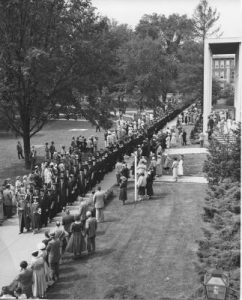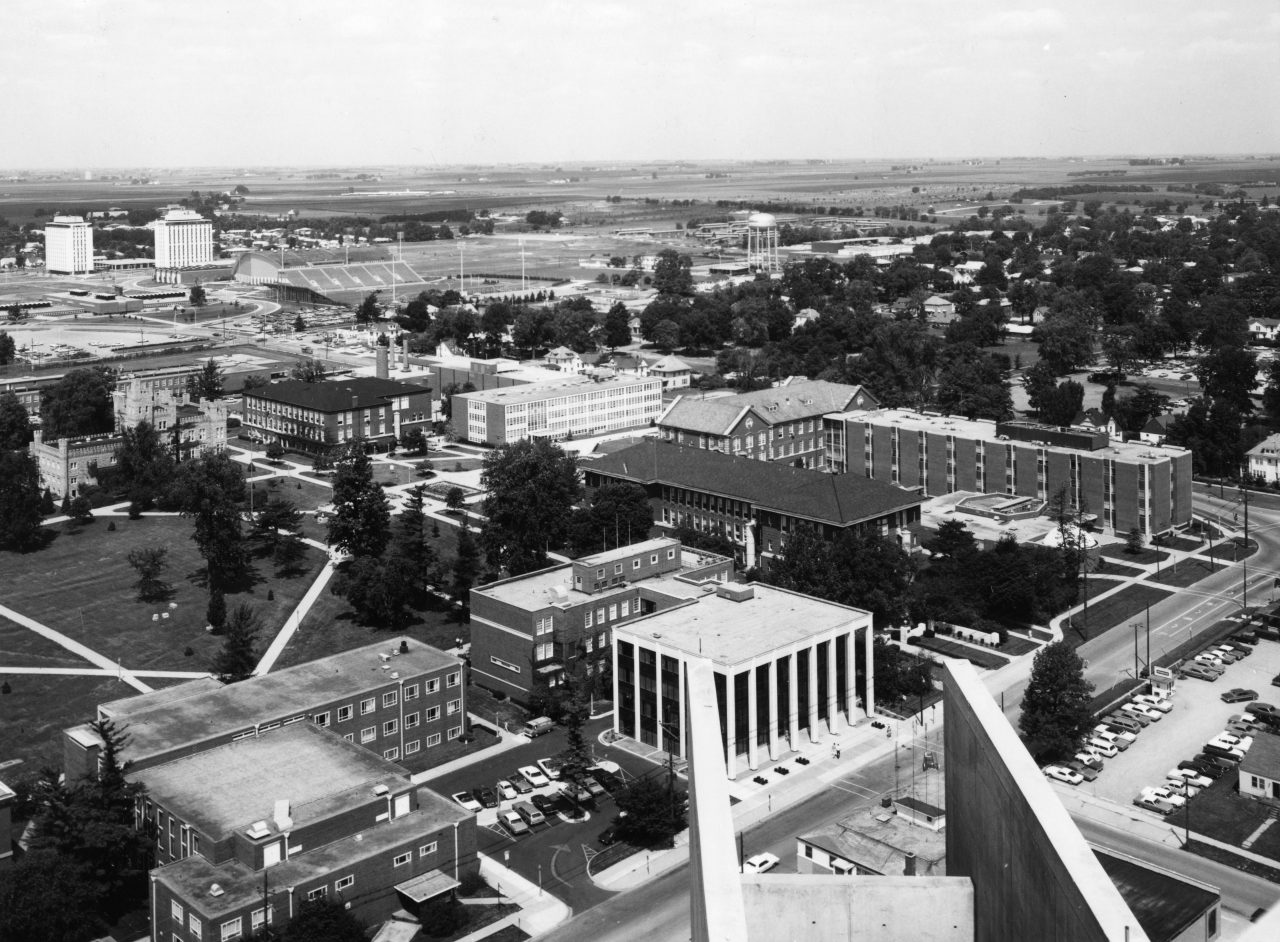
Commencement photo circa 1940s. (Courtesy of the Dr. Jo Ann Rayfield Archives, Photographic Services Collection, Illinois State University)
Illinois State Normal University (ISNU) was founded in 1857 with one purpose: to prepare teachers. The need for educators was great, as documented by faculty member Helen Marshall in her history of the University titled The Grandest of Enterprises. “The rapid growth in the population from 1840 to 1850 had been inevitably accompanied by a dearth of teachers,” Marshall wrote.
Given this immediate need dictated a single focus for the school, it is easily understood why the University was established with a narrow mission of providing a two-year diploma program in teacher education that later developed into a bachelor’s degree. What’s surprising is that the scope of study did not broaden further until nearly a century later, at which time a push for a graduate program began. Even then the objective of adding a master’s degree was to further enrich the teaching of future school teachers and administrators.
Efforts to create study options beyond the bachelor’s degree can be traced back to 1937. It was then, according to the University’s 1945–1946 course catalog, that a graduate committee began “preparing for the time when such an advanced program would be undertaken.”
Progress was made beginning in 1941, as representatives from the five state teacher colleges partnered with the University of Illinois in annual conferences to develop a five-year program of study ending with a master’s degree.
Illinois State’s objective in providing the graduate school option is made clear in the course catalog, which stated that classes targeted “students who wish to become master teachers in elementary schools, in secondary schools, or in junior colleges, or for those who wish to become guidance and personnel workers,” with “specific curricula available” for those working toward a principal or superintendent position.
Necessary authorization for the graduate programs to be added came during a July 1943 meeting of the State Teachers College Board. At Illinois State, the degree approved was a master of science in education. The departments offering it were listed in the course catalog and included education and psychology, biology, English, geography, mathematics, and social science. Foreign language classes were offered as well, but only during the summer.
The impact of adding graduate courses was felt across campus, and certainly within faculty ranks. The state board stipulated that graduate classes must be taught by those holding a doctorate or the equivalent in their field. Illinois State had 45 within the teaching ranks who had the needed credential. Improvements in facilities and equipment were also essential. The course catalog states that Milner Library was completed in 1940 with the idea of advanced programs becoming part of the University’s offerings.
“For a number of years, materials have been added to the holdings of the library in anticipation of a graduate program,” the catalog states, with ample funding available to expand the collection further. The University’s commitment and ability to add equipment in laboratories as well resulted in the promise of “opportunities for graduate students to do complete and thorough work comparable to that in the best institutions of higher education.”
“For a number of years, materials have been added to the holdings of the library in anticipation of a graduate program,” the catalog states.
Illinois State was consequently ready and eager to welcome its first graduate students in the summer of 1944, with Chris A. DeYoung overseeing the program. There were 38 who enrolled in the 32-semester-hour program that required completion of a thesis or equivalent, according to Marshall. Each applicant was required to take the Graduate Records Examination to be admitted and needed to budget approximately $400 for an entire academic year. The total expense, as explained in the course catalog, covered tuition and fees, books and school supplies, room and board, as well as laundry.
Charlotte Elizabeth Wilcox was the first graduate, receiving her master’s degree on June 4, 1945. She had earned an undergraduate degree from Illinois State in biology in 1940, and studied the same subject as a graduate student. Her thesis was titled “Rapid Methods for Health Teachers and Health Educators to Use in Spotting Stream Pollution,” according to Marshall.
Wilcox completed a second master’s degree in nursing from the University of North Carolina and a doctorate in health education at the University of Illinois. She married Robert Bothwell and taught for 37 years, including eight years at Illinois State. She retired in 1984 from a faculty position at Eureka College and died in 1993 at age 74.
Isabel Katherine Billings was the second graduate. She had earned a diploma at the University in 1926, followed by an undergraduate degree in geography in 1937. Her master’s degree in geography was completed in August 1945. She taught elementary students at Hawthorn School located in Oak Park prior to her death in 1994 at age 86.
The success of the graduate program was measured in part by how well those who earned the advanced credential did in their careers. A study done in 1954 through a survey of alumni from the first decade of the University offering the degree found that an average salary in 1953 was $4,520, with high school principals averaging $4,910, comparable to $43,803 and $47,583 respectively in today’s standards. Enthusiasm for more graduate school opportunities fueled the University’s continued expansion. By the early 1950s, students could complete a master’s degree in education from additional departments. These included art, physical science, health and physical education, music, speech, home economics, business education, or industrial arts.
While applauded as progress, then-President Robert Bone was not content to have advanced options remain at the master’s degree level. In May of 1958, according to Marshall’s history titled The Eleventh Decade, Bone presented plans for a doctorate program. One year later, the Graduate School was created with C. W. Sorensen chosen as its first dean. He left the presidency of Augustana College for the opportunity to lead Illinois State’s graduate program, which had an enrollment of 674 in 1964.
The Eleventh Decade documents that specialist and doctoral programs were initiated in 1962. Marshall reports that Odessa Heagy Mayer was the first to earn a specialists’ degree in education, awarded in August 1964. She died in 1998 at age 81. Herschel C. Fried of Maryland completed a doctor of education in art in 1965 to become the University’s first doctoral graduate.
It was in this same timeframe of the early 1960s that a push was underway to change the University’s name by dropping the word “Normal” because it indicated the school’s focus remained on teacher education. In reality, Illinois State had become a multipurpose university with a mission that had expanded beyond its initial objective to prepare educators.
The debate within the campus community was heated, but those favoring the change succeeded. In August of 1963, then Illinois Governor Otto Kerner signed the required legislation to change ISNU to Illinois State University. The new name was in place as of January 1, 1964, along with an anticipation of what was to come as a new era began.
The momentum for advanced study continued and in the 1970s, students created a Graduate Council. The group remains active today as the Graduate Student Association. New areas of study continued to be developed at such a pace that as of spring 1993, the University offered 35 master’s programs and 11 doctoral options. Graduate education marked its 50th anniversary that year with ample reason to celebrate, including the fact that more than 16,000 students had earned advanced degrees.
Progress has continued in the decades since, with the graduate program now celebrating 75 years. Enrollment is nearly 3,000. Research symposiums have been added along with the Three Minute Thesis research communication competition for both masters and doctoral students. There are additional degree options as well, with 37 master’s degree programs, an integrated bachelor/master’s program in accounting, two master’s of fine arts programs, one specialist degree program, seven doctoral programs, and 15 graduate certificates.
“There is no question that those who blazed a trail before us were visionary in recognizing the need for the University to add programs at the graduate level in the realm of education and beyond,” President Larry Dietz said.
“There is no question that those who blazed a trail before us were visionary in recognizing the need for the University to add programs at the graduate level in the realm of education and beyond,” President Larry Dietz said. “The growth has been so tremendous that Illinois State is now recognized as an institution with a reputation for igniting change across disciplines and around the world through graduates with advanced degrees who are equipped to problem-solve as confident and engaged leaders.”
Interim Graduate School Director Dr. Noelle Selkow is in contact with many of the successful graduates.
“We hear from our alumni that their graduate school experience at Illinois State made a positive impact on their lives and gave them the hands-on skills to be successful,” she said. “Our overall graduate enrollment is strong and students are performing remarkable research.”
Selkow appreciates the graduate program milestone as a time to celebrate all that has been accomplished since the summer of 1945. Mixed with reflection is anticipation about what is yet to come in the realm of advanced study on campus. Exactly what will be added or revised in the decades ahead is unknown. There is, however, certainty that students who opt to complete a master’s degree or doctorate education at Illinois State will be changed for the better because of the University’s unwavering commitment to gladly learn and teach.

